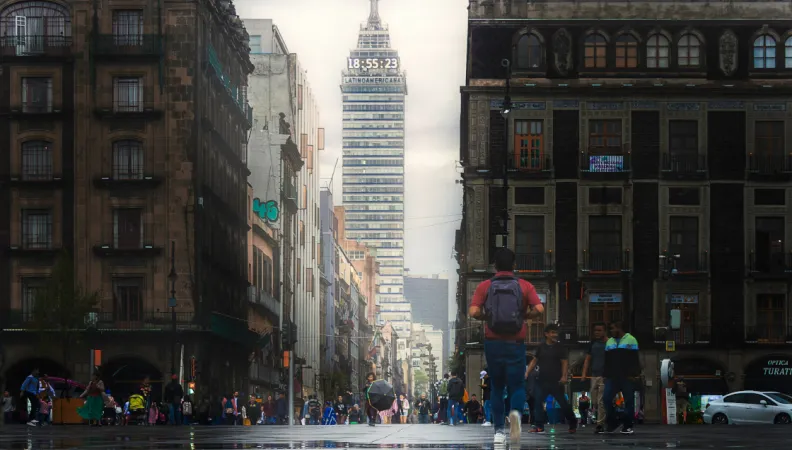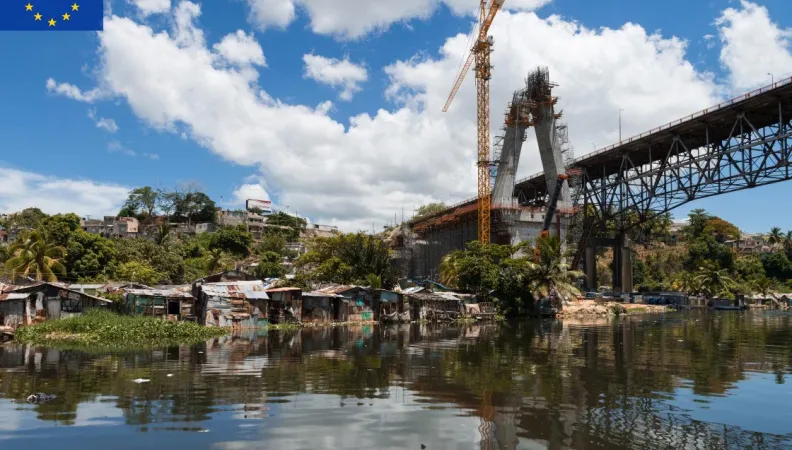Mexico City, Federal District, Mexico
Mexico city
Mexico
 Mexico is one of the 60 countries followed by AFD’s country-risk economists, whose assessments shed light on countries' economic trajectory and macroeconomic and financial situation.
Mexico is one of the 60 countries followed by AFD’s country-risk economists, whose assessments shed light on countries' economic trajectory and macroeconomic and financial situation.
Context
The second largest economy in Latin America, Mexico is committed to the fight against climate change, environmental protection and the energy transition. Its objective is to halve its greenhouse gas emissions by 2050. The country is also rethinking its growth with the aim of making it more inclusive. AFD has been supporting Mexico in these efforts since 2009.
Goal
Produced by AFD's team of country-risk economists, macroeconomic country assessments provide an analysis of development processes in countries in which AFD operates. They also characterize their growth trajectory, and detect economic, social, political and financial vulnerabilities associated with these trajectories. AFD Group is thus in a position to properly measure the challenges and monitor the risks associated with each of its investments.
Emphasis is placed on developing countries, particularly in Africa, for which macroeconomic analyses are rare or infrequent. AFD seeks to complement existing production on the global economic situation, more focused on advanced economies and major emerging countries.
Find out more: Macroeconomic Analyses at AFD
Method
Country-risk analysis is based on a close follow-up over a long period of time and rooted in a fine knowledge of local contexts. Cyclical trends, often highlighted in the news, are always examined in the light of structural trends and of the regional context in which they take place. The aim is to highlight country-specific macroeconomic issues while assessing risks against comparable time- and space-based trajectories.
Country-risk economists place the study of socio-political vulnerabilities, the growth model, the viability of public debt, external balances and the soundness of the financial system at the heart of their assessment, and give specific attention to countries' exposure to climate risks.
Lessons learned
Mexico is always on the front line when it comes to benefiting or suffering as a result of economic or political changes in the USA. Trump’s rhetoric aggressively attacks Mexico over the issues of migration and drug trafficking, and accuses it of being a Trojan horse for Chinese imports. While Donald Trump’s previous term of office suggests that we should not overreact to his threats towards his neighbor, some consider him to be more determined in 2025 than in 2017. The United States is surely set to restart the “trade war”, sparing neither Europe nor Asia in view of the substantial bilateral trade deficits, and always based on a transactional approach. In a context conducive to nearshoring, Mexico could reap the benefits through its geo-economic rent.
Download our publications on the macroeconomic situation of Mexico:
- "Mexico: Gauging the “Trump 2.0” risk", in MacroDev Semestrial Panorama #61 (February 2025)
- "Mexico: Never-ending emergence", in MacroDev Semestrial Panorama #48 (July 2023)
Contact:
- Sylvain Bellefontaine, country-risk economist, AFD
 Legal notice EU (project) AFD, AECID and Oxfam are committed to reverse rising inequality in order to reduce poverty in a significant and lasting manner through a human right approach. The research process will conduct a regional analysis, in west Africa and Central America, of the multidimensional inequality based on an innovative inequality framework which is being developed by Oxfam. The study will focus as well on the impact on inequality of a sample of public policies implemented in the regions in the last decade.
Legal notice EU (project) AFD, AECID and Oxfam are committed to reverse rising inequality in order to reduce poverty in a significant and lasting manner through a human right approach. The research process will conduct a regional analysis, in west Africa and Central America, of the multidimensional inequality based on an innovative inequality framework which is being developed by Oxfam. The study will focus as well on the impact on inequality of a sample of public policies implemented in the regions in the last decade.
Contexte
The world has seen a significant reduction in the extreme poverty levels in the past decades, led by strong economic growth from emerging economies. Despite the economic growth, the incomes of the poorest people all over the world are not keeping up. Eight out of ten people in developing countries live in nations where the income of the bottom 40% has grown slower than the rest of the economy (Hoy & Samman, 2015) and 7 out of 10 people live in a country where inequality has risen in the last 30 years.
Regarding Latin American and the Caribbean, although the region achieved considerable success in reducing extreme poverty over the last decade, its still-high levels of income and wealth inequality have damaged sustainable growth and social inclusion.
In West Africa, the sub-region had the largest average economic growth at 6.2 percent between 2010 and 2014 among Africa's regions, and compared with 4.4 percent for Africa during the period. However, there is growing concern that the benefits of this impressive growth have not been inclusive and equitably shared. The combination of high economic growth and stubbornly high income inequality rates remains a puzzle.
This project is part of a European facility for a research program on inequalities in developing and emerging countries which is coordinated by the AFD. Financed by the Development Cooperation Instrument of the European Union, this facility enables to implement 20 research projects over the period 2017-2020, in partnership with donors and research centers from the South to the North.
This project is part of the first phase of the Research Facility on Inequalities, coordinated by AFD and funded by the European Commission's Directorate-General for International Partnerships over the 2017-2020 period. The first phase of the Facility has led to the conduct of 22 research projects and the publication of around 100 research papers and policy briefs.
Objectif
Even if we know less unequal societies are desirable given their beneficial economic, social and political outcomes, there is still uncertainty on which are the best routes to understand and tackle inequalities through a multidimensional perspective. To contribute to this global conversation on inequalities, Oxfam, the International Inequalities Institute at the London School of Economics and the School of Oriental and African Studies of the University of London, are joining efforts to develop a conceptual and measurement framework on inequalities. The purpose of the framework is to provide analysts and practitioners with a theoretically-grounded means by which to gain a clear understanding of the nature of inequality and to use this information to develop and devise effective policy responses with the long-term goal of reducing inequalities, tackling deprivation and improving well-being.
Méthode
The framework is designed to capture the multidimensional nature of inequality, which is experienced across a number of 7 life domains, and given that there are many different forms of inequality (such as concentrations of wealth, pay gaps, dispersion of income, social gradients in mortality, and greater social isolation experienced by the elderly). The framework is based on Amartya Sen's capability approach. The focus of this approach is an assessment on what life we lead and what we can or cannot do, and can or cannot be; the quality of life that individuals are able to achieve. Equally important, this framework should enlighten the discussion on inequalities in a way that allows for context-specific diagnosis and policy recommendations, so that it can support the strategic work of practitioners and key stakeholders of the development arena.
See this project's 2 minutes pitch from Ana Claver, Project Manager on Inequalities at Oxfam Intermón:
Résultats
Evidence from more than 150 countries, rich and poor alike, spanning more than 30 years, shows that overall, investment in health, education and social protection reduces inequality. Nevertheless, we still need to know more about what are the concrete mechanisms that make these inequality reductions happen, and how certain policies should be designed so that they tackle spatial, gender and ethnic inequalities in an effective manner. We expect to draw lessons from those different scenarios by this comparative research.
The researchers involved in this project anticipate that active citizenship is a means to achieve development, because it enables women and men living in poverty to raise their voice in defence of their rights (health, education, jobs, dignity). Moreover, they presuppose that public policies amplify their effectiveness when citizens are involved in their cycle. They also presume that women and girls plus youth are the groups especially impacted by multidimensional inequality and thus, they should be carefully considered in the research.
Find the presentation of the research paper "Multidimensional inequality in Western Africa" by Ana Claver Muñoz and Cristina Rovira Izquierdo, project manager on inequalities and inequality programme advisor at Oxfam Intermón during the fifth webinar of the Research Facility on Inequalities:
You may find the deliverables linked to this project here:
West Africa Report:
- Analysis of multidimensional inequalities in West Africa and a strategy for inequality reduction (in English)
Central America and Dominican Republic Report:
- Analysis of multidimensional inequalities in Central America and Dominican Republic, and a strategy for inequality reduction (in English)
Policy briefs:
- A strategy for reducing inequalities in West Africa (in English)
- A strategy for reducing inequalities in Central America and the Dominican Republic (in English)
You may also find a short presentation video of the Multidimension Inequality Framework (MIF) used in this research project (in English):
Contact:
Anda David, Research Officer, AFD
